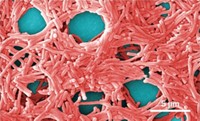Advertisement
Grab your lab coat. Let's get started
Welcome!
Welcome!
Create an account below to get 6 C&EN articles per month, receive newsletters and more - all free.
It seems this is your first time logging in online. Please enter the following information to continue.
As an ACS member you automatically get access to this site. All we need is few more details to create your reading experience.
Not you? Sign in with a different account.
Not you? Sign in with a different account.
ERROR 1
ERROR 1
ERROR 2
ERROR 2
ERROR 2
ERROR 2
ERROR 2
Password and Confirm password must match.
If you have an ACS member number, please enter it here so we can link this account to your membership. (optional)
ERROR 2
ACS values your privacy. By submitting your information, you are gaining access to C&EN and subscribing to our weekly newsletter. We use the information you provide to make your reading experience better, and we will never sell your data to third party members.
Environment
Flint’s water woes lingered
A failure to properly treat the city’s drinking water caused high lead levels and disease outbreaks
by Michael Torrice
December 14, 2016
| A version of this story appeared in
Volume 94, Issue 49

Just five days into 2016, Michigan Governor Rick Snyder declared a state of emergency in Genesee County in response to high lead levels in the city of Flint’s drinking water. This declaration followed months of work by scientists and activists to alert government officials that something was wrong with Flint’s water.
The city’s water woes started back in 2014 when it stopped taking treated water from the Detroit Water & Sewerage Department and instead began treating water from the nearby Flint River. The city’s treatment plant didn’t effectively optimize this new source of water to prevent it from corroding pipes in the city’s distribution system. This corrosion leeched lead into the drinking water.
The entire crisis might have been avoided if the city had added an orthophosphate corrosion inhibitor to the water, says Marc A. Edwards, a Virginia Tech environmental engineer who led a team that studied Flint’s water problems. Other factors contributing to the water’s corrosiveness were a relatively low pH and high chloride levels.
Edwards’s team also determined this year that outbreaks of Legionnaires’ disease in Flint in June 2014 and May 2015 were likely linked to the city’s corrosive water (Environ. Sci. Technol. Lett. 2016, DOI: 10.1021/acs.estlett.6b00192). The lung infection is caused by Legionella bacteria that can lurk in drinking water systems. Flint’s corrosive drinking water leeched iron out of city pipes, which could have fed the bacteria’s growth and reacted with and eliminated chlorine disinfectant.
Flint is back to taking water from Detroit. Recent measurements by the Michigan Department of Environmental Quality and Edwards’s team show that lead levels in the city’s water are dropping. Some homes still have levels above a regulatory limit set by the Environmental Protection Agency.
The city hopes to replace lead pipes throughout its distribution system. But a study this year from researchers at Dalhousie University suggested that for such replacements to effectively lower lead levels, they must be complete—all pipes must be replaced between water mains and a home, not just up to homeowners’ property lines (Environ. Sci. Technol. 2016, DOI: 10.1021/acs.est.6b01912). Partial replacements can actually increase lead levels because of electrochemical reactions that corrode the lead, the study found.
C&EN's YEAR IN REVIEW
Top Headlines of 2016
- Hawaii explosion cost a researcher an arm
- TSCA reform crossed the finish line
- U.S. elected Trump as president
- The periodic table got four new elements
- Post Dow-DuPont, chemical deal-making waned as 2016 advanced
- Labs made advances in Zika research
- Four ag giants to rule them all
- 2016 Nobel Prize in Chemistry at a glance
- Brexit bomb exploded
- Focus returned to Iran's chemical industry
- Overtime pay limit doubles under Obama administration
- The CRISPR craze continued
- Perfluorinated compounds got increased scrutiny
- From the lab to the market
- Paris Agreement to curb climate change took off
- World chemical production at a glance
- Flint's water woes lingered
- As China's economy slowed, chemical makers adjusted
- Mostafa A. El-Sayed won the 2016 Priestley Medal
- ACS members on average fared better than young graduates in employment surveys
- ACS invests internationally
- Spun-off firms found their footing in 2016
- Remembering the Nobel laureates we lost in 2016
- ACS proposed chemistry preprint server
- Berkeley College of Chemistry avoided reorganization
- Fight against opioid epidemic continued in 2016
- Noble gas shortages averted, for now
- The shale gas boom by the numbers
- Crop protection products in the crosshairs
- ACS launched new journals
- Website search terms of the year
- Biobased materials hit the big time
- No better deal emerged for Mossville, La.
- U.S. prepares for national food labeling standard
Top Research of 2016
- Mini factory made drugs on demand
- World's first PET-munching microbe discovered
- Liquid metals went to work
- Methylene activation reached new heights
- Biological structures of the year
- Wearable sensors were 'the' fashion accessories of 2016
- Scientists beefed up the antibiotic arsenal
- An enzymatic route to carbon-silicon bonds
- Single-atom catalysts gained a toehold
Revisiting Research of 2006





Join the conversation
Contact the reporter
Submit a Letter to the Editor for publication
Engage with us on Twitter